Pick
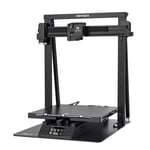

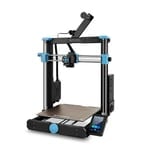
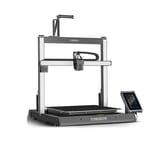
Sometimes, you don’t want to break up that large part into smaller, easier-to-print pieces for your average-sized 3D printer at home. Whether for part strength, geometric complexity, or, let’s be honest, pure laziness, there are times when a large-format desktop 3D printer is exactly the right tool for the job. We get that.
Picking a large 3D printer is pretty straightforward – there’s only a handful of them out there to begin with. Choosing one that’s going to make the printing easier is where it gets trickier. Well, we’ve gone hands-on with a few 3D printers we consider to be large – an assortment of machines featuring a whopping 400 x 400 mm+ build area. So, which ones are worth your attention? Read on and find out.
A large 3D printer, much like any 3D printer, should be reliable and easy to use. In this category though, the build volume is really the defining feature that makes a particular machine really stand out. The question is, what do we consider to be a “large” 3D printer?
From our perspective, you can generally group work areas into one of four sizes in consumer 3D printing. Small, with around 180 x 180 x 180 mm build areas, Standard, offering approximately 250 x 250 x 250 mm build areas, Mid-sized, with 300 x 300 x 300 mm, and Large, which often boast build zones of 400 x 400 x 400 mm+.
Large-format 3D printers have their own distinct challenges to overcome, challenges that are exacerbated by their size. Their construction has to be rock solid in order to withstand their heavy weights, not to mention stresses from hefty moving parts during the printing process. Depending on the printer’s design, the motion system must also be up to the task of managing the inertia of a large moving print bed. Modern firmware is also desirable, to help mitigate vibrations from printing entirely for high-quality printing at speed.
Stability throughout the height of the print volume is a must, too, so bracing and brackets to eliminate play in the frame of the printer are also desired items, adding to the overall sturdiness of what are substantial FDM machines.
Large-format 3D printers, particularly low-cost ones, are unlikely to have perfectly flat print beds. Sensors and probes to compensate for any unevenness in the print bed are therefore a must-have feature to ensure a decent first layer, which is critical to the success of a print.
Printing with a large format 3D printer can mean multi-day prints that gobble up a large amount of filament. A filament runout sensor at least eliminates any doubt about whether the currently loaded spool has enough filament left to complete a job, pausing your print when the spool is empty. That can potentially save days of wasted time, and filament.
To speed up these big prints, you should investigate nozzle options for your chosen 3D printer. Many machines come equipped with 0.4 mm nozzles from the factory, which, while offering a decent balance of detail and speed for general printing, is inadequate for rapid large-scale printing. Larger bore nozzles allow you to print thicker and wider layers, cutting print times dramatically and increasing print strength. It’s certainly something worth exploring if you want to produce bigger prints quicker.
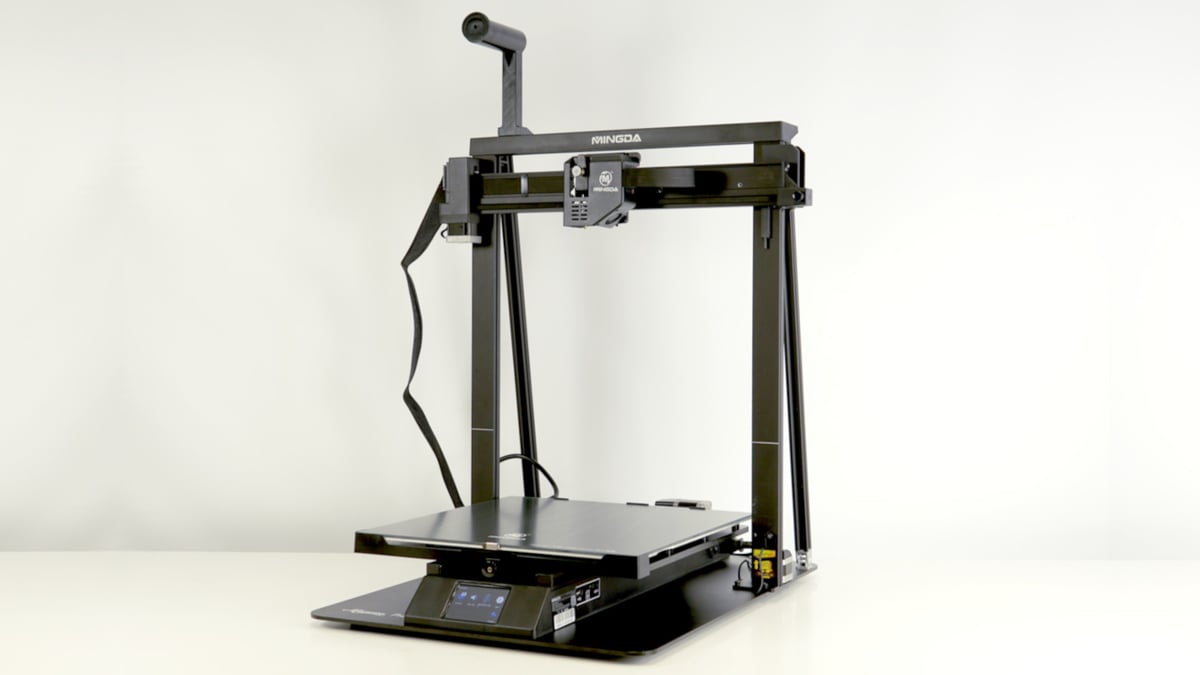
There are hot new speed-oriented large-scale printers now, and while the Mingda Magician Pro isn’t one of them, the pricing pressure from the newer machines means this former upgrade is terrific value right now.
The Mingda Magician Pro comes with all the bells and whistles you’d expect from a pricier printer, including a direct extruder, a simple-to-use touchscreen interface, a full metal base plate, and an excellent 400 x 400 mm textured glass build surface.
What you need to know for now is that the Mingda Magician Pro comes with plenty of nice kit, including a direct extruder, a simple-to-use touchscreen interface, a full metal base plate, and an excellent 400 x 400 mm textured glass build surface.
We found it easy to assemble the Magician Pro, thanks to a detailed manual with plenty of pictures and included tools. We were actually up and running in under 30 minutes.
The Magician Pro features automatic bed leveling, making use of a strain gauge, where the nozzle touches the bed to detect imperfections, which resulted in great first layers, despite the texture on the surface of the glass bed. The resulting prints felt extra smooth where the print had been in direct contact with the print bed. A metal base plate and supports for the gantry added to the system’s stability.
The large bed retains heat well and was suitably hot even towards the edges, which is something that can often be inconsistent in beds of this size. Mingda’s textured glass worked well with larger prints, but we found a raft or brim necessary for small prints.
For a large 3D printer, the Magician Pro is remarkably quiet, with the only notable noise coming from its cooling fans. Otherwise, it hardly makes a sound.
The system’s direct extruder performs well, putting down consistent prints without intervention or fuss. By nature of its design, you’re forced to print a smidge slower than similar printers with Bowden extruders, but there are other ways to save time printing at this scale.
One such way would be with larger-bore nozzles. Frustratingly, Mindga includes nothing other than a 0.4 mm brass nozzle. On the other hand, the printer uses a V6-style hot end, meaning any V6-size nozzle should be compatible. We did find minor adjustments to the stock printing profiles were necessary to cut back on stringing, but with stock Cura as the provided slicer, such changes are straightforward.
Overall, the Mingda Magician Pro is large, sturdy, and has the bones for you to comfortably get on with printing large objects. It is simple to assemble, and you’ll be printing quickly out of the box.

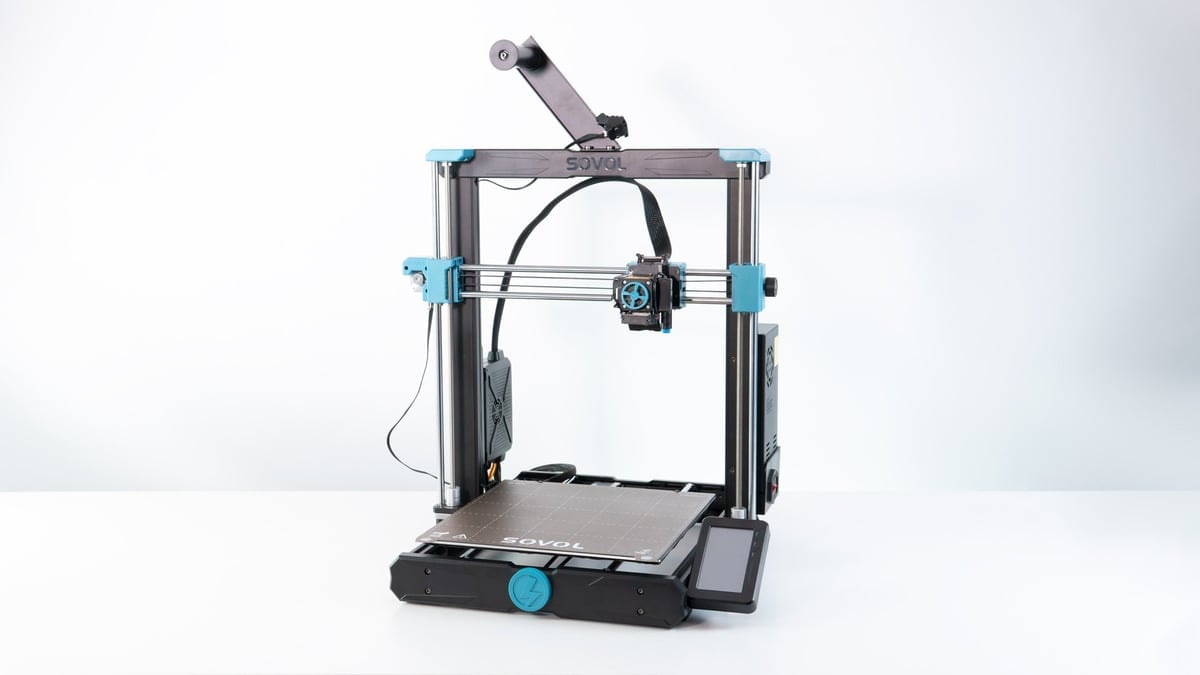
With prices in flux a little, we don’t really have a clear budget large-format recommendation to point to right now. So, instead, we’ll throw a little curveball and suggest that perhaps a mid-size 3D printer is a fine alternative to save a buck.
While it doesn’t have the 400 x 400 x 400 mm+ large build volume we normally look for, the Sovol SV06 Plus does offer a removable PEI-coated print bed, auto-bed leveling (using an inductive probe), Sovol’s highly capable planetary extruder, a long high-flow nozzle fitted to a hot end reaching 300 °C, a filament sensor, and a large, colorful touchscreen UI.
The SV06 Plus holds more than a passing resemblance to the terrific Original Prusa i3 MK3S+, with steel rod-guided axes that are sturdy and suitable for picking up the print speed. We’ll note there seems to be a bit of a break-in period with the printer’s scritchy-scratchy-sounding bearings beneath the print bed, but ultimately it’s a quiet, nicely built system.
Material compatibility is wide, with the SV06 Plus rated for PLA, PETG, ABS, and, as with the SV06, flexibles such as TPU. We must point out that we’ve found the SV06-series’ extruder to struggle to print TPU, with the noodly filament easily tangling in its planetary gearing. As often seems to be the case, caution with your print settings is advised to coax the SV06 Plus into confident printing of flexibles.
It’s quiet, capable, and mercifully fast. If you can stomach the cutesy astronaut loading animation and colorful scheme of its touchpad UI, then the SV06 Plus is a great option for printers on the upper-end of mid-sized. It’s not quite a large-format printer, but at under $300, it’ll likely make you reconsider whether or not you need that extra 100 mm of space across the X- and Y-.

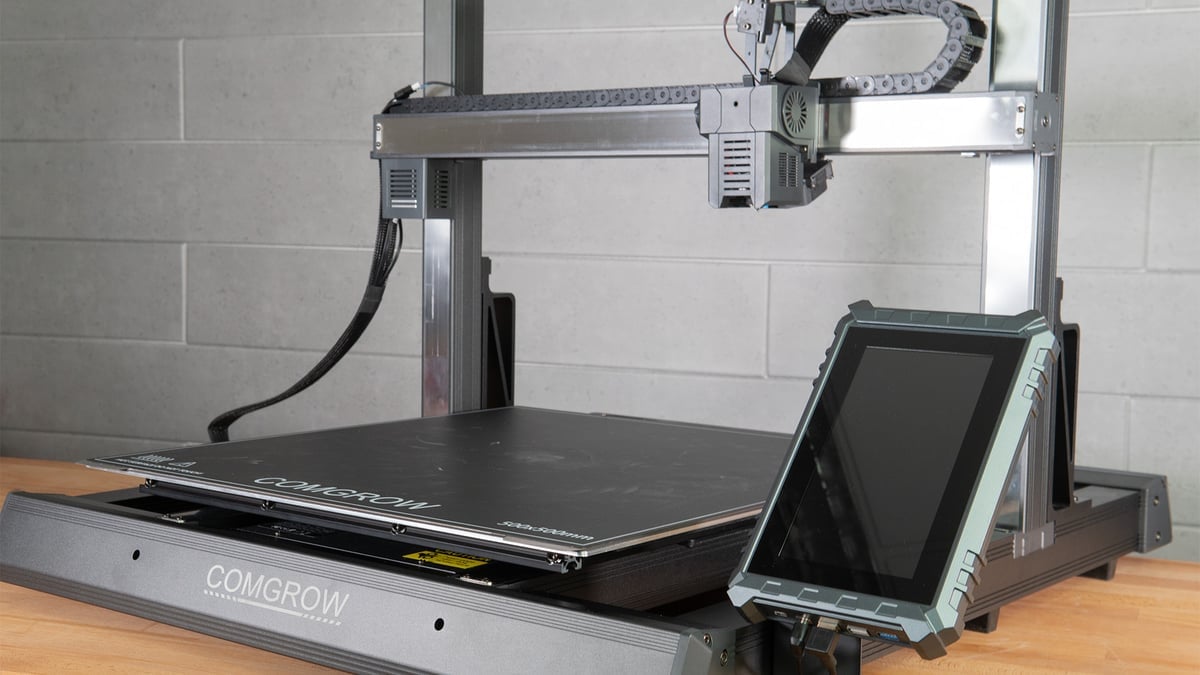
Where did this come from? Comgrow is perhaps better known as a service partner and distributor for Creality, not as the maker of massive, Klipper-enabled high-speed printers. Maybe this changes here because the T500 is precisely that and more.
Packing a 504 x 504 x 504 mm build volume, the T500 has an appreciable 5 cm in the X- and Y-axes over our other picks, making it the largest printer to feature. Besides this, you have an absurdly solid construction, with Comgrow using something of a modular design, with the motion system catered to by the kind of linear modules you’d find on Snapmaker machines. In a nutshell, it’s heavy-duty.
While the T500’s frame is not supported with the kinds of braces found on similar large printers, we’re inclined to think they’re not necessary. The contact surface area between the X- and Z axes frame and the printer’s base is large and supported by two 90-degree brackets to ensure a secure fit.
Performance-wise, the T500 is outfitted with a reduction-geared extruder and a proprietary nozzle with an elongated melt zone (not dissimilar to the Volcano type designed by E3D, but not compatible) for high-flow printing. Included in the box is a variety of spare nozzles that go up to 0.8 mm, which you would think is a no-brainer for usability with large-volume printers but is actually unusual. You would be waiting days, if not weeks, for a full-volume print on a stock 0.4 mm nozzle. Swapping in the 0.8 mm nozzle cuts this down dramatically.
Also cutting the overall print time is the T500’s max print speed of 200 mm/s, helped in part by the printer’s use of Klipper and its input shaping feature. An accelerometer unit is included, which lets you calibrate the printer to counter any resonance that would otherwise impact the quality of your prints. By nature of its design, though, the T500 is shifting a lot of weight as it moves the bed. While you have firmware-based trickery to reduce artifacts on the prints, don’t expect to let the T500 rip with the kinds of speeds we’re seeing elsewhere with Klipper-enabled 3D printers these days.
In testing we found the T500’s print bed surface tricky to dial in, with first layers often requiring a close eye and the occasional Z-offset tuning to keep prints firmly lodged to the bed. A key thing to note about the T500 is that the print bed only reaches 80 °C, with a significant drop-off toward the edges. Don’t expect an easy time with warp-happy materials across the full expanse of the print bed.
Wi-Fi connectivity lets you tap into detailed diagnostics remotely via a web browser, one of Klipper’s superpowers. The T500 uses Fluidd for its UI, which is something of a standard for stock Klipper 3D printers today. By simply tapping in the printer’s IP address, you get access to a wealth of features, including job queues, G-code editing, full printer control, bed mesh visualization, macro commands, real-time control over virtually every part of the printer, and more.
The detailed instructions provided with the printer, plus a thoughtful design that means the printer is assembled upright, give a pleasant initial experience with the build needing no more than fifteen minutes, all told. As far as user instruction goes, it ends there. The T500 and its raw Klipper experience are more advanced than your typical desktop 3D printer, and Comgrow currently does not provide any documentation to help newcomers get going. Using a pre-configured Klipper setup should be relatively self-explanatory to any technically minded folk, so the difficulty curve is not severe.
The larger build volume, slight speed boost, flexibility of the software, and a big bag of nozzles that will shorten your print time make it a worthwhile upgrade for churning out chunky PLA parts, even at ~$799.

Believe it or not, our job does have its downsides. Yes, we play with printers and write about them for a living, but there are so many 3D printers to get through that we sometimes fall behind in certain areas. One such area is the one you’re in right now.
We have a whole stack of large 3D printers to catch up with now, and that’s something of a priority for us in 2024. For a start, there’s the utterly mad Elegoo OrangeStorm Giga and its absurd 800 x 800 x 800 mm build volume. Around 2,000 backers pledged a combined $3.38-million on Kickstarter to bring this massive printer to life, so we’re not the only ones excited by its potential. All Elegoo must do now is deliver, as it’s not the only company building printers that large…
Elegoo has recently seemed quite interested in adding bigness to its stable. They’ve another big 3D printer in the back of the Elegoo barn, munching away on some hay. This one is the delightfully large Neptune 4 Max. With a 420 x 420 x 480 mm build volume, it isn’t quite as large as the Comgrow T500 listed above, but it has a 300 °C hot end, a direct extruder, Klipper firmware, and can print at speeds of up to 500 mm/s. It’s also comfortably under $500 at $439. So, that’s looking like somewhat of a bargain – if it performs up to standards.
Anycubic has a big boy in the game too, the Kobra 2 Max. This is a machine we did briefly get to test a while back, but it didn’t make much sense to dive fully into it, given it was basically unfinished at launch. Anycubic’s disappointing release has almost pushed it out of consideration altogether.
As we mentioned earlier, Elegoo isn’t the only company building silly-big 3D printers. Tronxy, a perennial black horse among 3D printing manufacturers, has a machine called the Veho 1000 in its stable. This is a printer with a build volume of 1,000 x 1,000 x 1,000 mm, which is so big you might have to send your child away to boarding school just so you have a room for it to go in. By the way, if that’s just too large for you, Tronxy also makes a Veho 800, with an 800 x 800 x 800 mm build volume. Nice and compact, then.
Last but not least, there are a couple of successors to picks in this piece. Mingda has released the Magician Pro 2 to follow up on the Pro, and it looks to offer small, relatively minor improvements, with perhaps the most notable addition being a removable PEI print bed. In general, it seems an all-around improvement on a fine large-scale printer and has already replaced the original Magician Pro in some markets.
We fully plan on getting our paws on some of the big boys mentioned above in 2024. Until then, we’re sticking by our original picks in this category.
Follow along with our shifting opinion on the best small 3D printers over time. Here is how we’ve updated this guide.
Update – February 20, 2024: For now, and quite possibly only for now, the list remains unchanged. This is primarily because we’re a little behind with our printer testing in this category. There are more than a few hot prospects coming up through the ranks when it comes to large-format 3D printers though, as mentioned above in our Other Machines section. Watch this space!
Update – October 19, 2023: We’ve gotten to grips with the gargantuan Comgrow T500, and it’s really rather good, with a clean Klipper experience and large nozzles for quicker large-scale printing. Elsewhere, the Mingda Magician Pro has had a price cut, making it our new top-value recommendation and, for lack of better, cheaper options, we feel if you need to be saving money on a larger-scale machine, then looking to a smaller, mid-size machines is the route to go, with the Sovol SV06 Plus slipping in as our budget pick. It does bend the rules of our guide a little, but does so for the sake of giving recommendations we can stand by.
Update – May 18, 2023: The Anycubic Chiron has gone the way of the dinosaurs, so it had to be replaced on this list. In swoops the Elegoo Neptune 3 Max which is now both the largest and cheapest 3D printer on this list. We also added a note to the Other Machines section about our poor experience with the promising-looking Creality CR-M4. Ours was DOA, and support seems non-existent.
Update – November 11, 2022: We’ve transitioned this guide away from our older style to a new three-pick format, giving a better indication of what we’re looking for in a large 3D printer.
We have also changed the criteria for the large format 3D printers to better suit what a typical consumer would look for. The most significant change is the minimum size to make this list, which is now a larger 400 x 400 x 400 mm. This means many printers included on our previous list had to go. We have also reduced the cap on how much what we consider a consumer 3D printer should cost to $1,000. We have a separate guide to large professional printers, which may be worth a look if you need one for your business or are looking to spend more.
Dropped from this list are Creality Ender 5 Plus, Tronxy X5SA-500 Pro, Vivedino Troodon, Modix Big60 V3, gCreate gMax 2, and the Modix Big-40 3D printers.
If there’s one thing that testing a lot of 3D printers has taught us, it’s that maintaining a broad benchmarking scheme for 3D printers is impractical for getting a sense of what a 3D printer is like to use and live with. Holding a sub-$200 self-assembled printer for hobbyists to the standard of a $6,000 production machine designed to handle engineering-grade materials won’t tell you that the former is a breeze to set up and the latter a tangled web of firmware updates, buggy systems, and unreliable performance.
We want our reviews and buyer’s guides to cut straight to the chase. What is it like to use a printer? What are the defining features like? What didn’t we like? And, more importantly, is it worth the money? We don’t want to get bogged down benchmarking numbers out of context or hung up on issues affected by more variables than we can control.
Our buyer’s guides and reviews take the intended end user of a 3D printer into consideration. We imagine what they’re likely to do with it and focus the testing on challenging this. If we have a large-volume printer, for example, we’ll be printing – surprise, surprise – large prints, making use of the entire bed, and checking the performance at the limits of Z-height.
Other points of consideration for what makes the best 3D printer include ease of use, supporting software, and repair options. If something goes wrong, how easy is it to fix the machine? Does the documentation or customer service provide adequate information?
We strive to answer all these questions and more in our quest to find the best 3D printer for you.
Trust is important to All3DP, so our product testing policy is strict. When sourcing test units from a manufacturer, we do so under a zero guarantees policy. We make no guarantee of coverage in exchange for the printer, and the first time a manufacturer sees what we think is when we publish the content.
If a manufacturer doesn’t reclaim the unit after testing is complete, it is donated to a local cause or goes into deep storage for responsible disposal later. We occasionally buy machines for testing, too. In such cases, machines purchased by All3DP either remain in the office for team usage or are donated or disposed of in the manner described above.
Manufacturers or benefactors donating units for review do not influence the outcome or content of the reviews we produce. To the best of our ability, we will investigate abnormal issues with the manufacturer to glean better context or get insight into their awareness of the problem. But we make no excuses for poor design or bad QA.
One method we monetize our content at no additional cost to the reader is through affiliate product links. If you click on a shopping link featured in our buyer’s guides and reviews, we may receive a small commission from the store if make a purchase. This is at no additional cost to you. For more meaty content policy details, we cover it all in the advertising and commercial activities section of our terms of use.
For most readers, our top recommended 3D printers are your best bet in a given category.
But, facing the fact that there is no one-size-fits-all solution to home 3D printing, we’re here to help. Here are some pointers to orient you in this terminologically dense but wonderful world. (A word on terminology, we have a handy glossary of terms to know at to bottom of this article.)
Many 3D printers pitched for “beginners” or children go to such lengths to baby the user that they quickly become claustrophobic experiences. You will encounter more limitations than possibilities as your experience grows. If you aren’t satisfied with a “beginner” 3D printer’s features, we’d recommend a budget pick instead. You’ll save a little money, and the opportunity to learn by doing is far greater. And if something goes wrong, there are giant tribes online for each printer that have already asked and answered every question under the sun.
While the general quality of budget 3D printers has dramatically improved in recent years, quality control is often lacking. While manufacturers with large user bases are adapting to meet the demands of their newfound fans, including better customer support, there are usually better wells of knowledge to be found in the owners themselves, who contribute to the vast forum knowledge bases for some 3D printers.
We have zero obligation to manufacturers to sugarcoat what we find, and the first time they read it is when you do too. That’s why you can trust our reviews. We don’t pander to anyone, and our experience with the printer is what you read on the page.
If you can’t find any information about a printer you’d like to know more about, let us know at editors@all3dp.com.
A 3D printer for the home is rarely ever a one-and-done investment. Besides the continual purchase of materials, maintenance costs on perishable printer parts can stack up – think nozzles on an FDM printer or FEP film on an MSLA machine. Of course, parts can wear down or break, too, meaning sourcing replacement parts is a sensible consideration if you plan to print long-term. Printers with roots in the RepRap movement and open-source designs will be easiest to source parts for, with off-the-shelf components part and parcel of the design ethos behind them. Enclosed-design printers aimed at beginners may offer the gentlest introduction to printing, but your options to source spare parts will often be limited to the manufacturer. That’s if you can even get to and diagnose the problem.
The thrill of a new hobby will only sustain you so far. Being the desktopification of an otherwise complicated manufacturing process, expect to encounter, sooner or later, problems with a home 3D printer – even the occasional show-stopping issue. Having an end goal in mind for your printing gives you purpose and a reason to learn the solutions to the problems. Printing simply because it looks cool will result in a small mountain of useless doodads and, eventually, disinterest at the hands of cost, frustration, and the buildup of useless plastic trash.
Most home 3D printers are single extrusion fused deposition modeling machines, meaning a single printable material extruded through a single nozzle. Versatile enough for many applications through material compatibility, they’re safe machines to start with. But if you know you need to print objects with challenging geometries or semi-enclosed volumes, a dual extrusion printer would make your printing far easier. Likewise, single objects that need to have different material properties will only be achievable with dual extrusion. A resin printer will be the way to go for high-detail miniatures. Understand the technologies to find a printer that best suits your needs.
While the size of FDM 3D printers can vary greatly, the spillover is small. You’ll get some emissions from the filament melting, cloying the air, making it inadvisable to spend prolonged periods nearby. Generally speaking, the cleanup is minor and relatively easy to contain, depending on the models you print.
Resin 3D printing, however, is dramatically different and has unique demands that should make you think twice before investing. To varying degrees, the resin is smelly and toxic to you and the environment. It requires dedicated cleanup stations and personal protective equipment. You typically need 95 %+ isopropanol to clean prints and dissolve uncured resin from surfaces.
All printers should be operated in well-ventilated spaces, but this applies doubly to resin 3D printers.
While many excellent 3D printers have gotten their big break on Kickstarter, there’s the unavoidable issue that the platform is not a store. You are not buying a printer when you commit money to a campaign on Kickstarter; you are backing a vision. It’s putting money into the pot to help a company or person trying to achieve something.
You get nothing in return if a project is grossly mishandled and the money disappears. Often what you do get is the beta version of the product. You are paying for early access and all the wrinkles across all stages of the product that come with it.
We’re seeing more big-name companies turning to Kickstarter than ever to launch their products – it’s a safe way for them to gauge demand and drum up some interest against the pressure of a ticking countdown. Despite many companies being capable of outright launching products, they go cap-in-hand to enthusiasts with the promise of shiny new tech. Don’t be that user unless you absolutely must be the first to use a product and have money you can afford to lose.
We don’t think it’s worth the risk, but in the interest of cool new tech, report on new campaigns with our news coverage. You will never see a Kickstarter 3D printer in our buyer’s guides unless it has completed its campaign and the printer is widely available at retail, with all the protections that come with buying from a store.
But where’s the UltiMaker? Or Formlabs? What about Raise3D? Desktop Metal?
In the past, we’d list the best professional 3D printers alongside what we consider consumer or hobby-oriented machines (the printers we mainly focus on). An apples and oranges comparison, we know.
With this in mind, we created All3DP Pro, a wing of our content exclusively covering the professional applications of 3D printing and additive manufacturing solutions. Here’s a selection of articles covering the best 3D printers for professional use to get you started.
Choosing the best 3D printer is tricky, not least because the terminology surrounding 3D printing is dense. Here are some need-to-know terms, their explanations, and useful links to help you on your way to 3D printing mastery.
FDM: Fused deposition modeling, otherwise known as FDM, is a 3D printing process that extrudes heated thermoplastic material through a moving nozzle to build an object layer by layer. FDM is a trademarked term, which led to the RepRap open-source movement to coin the alternative phrase “fused filament fabrication” (FFF), but the two are interchangeable.
Filament: Filament is the base material used to 3D print objects via FDM. The filament is typically a solid thermoplastic fed to a print head, heated to its melting point, and extruded through a small nozzle. Filament is commonly available in spools of either 1.75 mm, 2.85 mm, or 3 mm diameter widths – dimensions that dictate the printers that can use them.
G-Code: G-code is the machine language used to instruct computerized tools such as 3D printers. Giving coordinates and instructions for tool heads and other non-movement functions, it is almost exclusively generated by slicing software. It comprises a library of commands to control specific actions like motion, speed, rotation, depth, and other related switches and sensors used in a machine’s operation. You can get to grips with G-code in no time with our guide to G-code commands.
Heated bed: This is a build plate that is heated so that the few layers of extruded plastic are prevented from cooling too quickly and then warping. A heated bed is essential for working with ABS or PETG materials but not so much with PLA.
Hot end: This is the cluster of components that heat and melt the plastic for deposition through the nozzle.
Extruder: Used by some to describe the entire system of parts that pushes and melts filament, extruder can also refer specifically to the motor and accompanying gears that grip the filament, feeding it to the hot end. How the extruder is arranged can affect the printer and its capabilities. There are two common arrangements: Bowden and direct. It’s a messy subject with overlapping terms and technical explanations; our guide to 3D printer extruders gives you all the knowledge to make sense of it.
Bowden: A style of extruder that sees the extruder motor positioned away from the hot end – typically the structural frame of the printer or on one end of the X-axis gantry. So-called for the Bowden cable and its action of allowing a wire to move freely within tightly constraining tubing, the Bowden extruder feeds filament through a PTFE tube directly into the hot end.
Direct Extruder: The other commonly seen extruder type, a direct extruder sees the extruder motor and associated feeding mechanism mounted directly to the hot end, with barely any distance between the feed and the melt zone of the hot end.
Dual Extrusion: Some 3D printers carry two extruders/hot ends, allowing them to incorporate multiple colors or materials into the same print job. While the obvious appeal comes from the possibility for decorative two-tone prints, the real benefit of dual extrusion systems is combining different materials, such as dissolvable support material, to enable the printing of otherwise impossible geometries. It’s a deep topic worth exploring more in our guide to all you need to know about dual extrusion.
PLA: Polylactic Acid, otherwise known as PLA, is a thermoplastic commonly used as a material for printing with FDM 3D printers. It’s easy to work with and is available in many colors and finishes. PLA is somewhat brittle – don’t expect to print strong items with it – but it remains popular for decorative printing thanks to its low cost. You can learn more about PLA in our guide dedicated to the topic.
SLA: Stereolithography is a 3D printing technology that falls under the broader process of vat photopolymerization. The term is often (incorrectly) used to describe all methods of vat polymerization – really, it’s a particular technology that uses a directed laser beam to trace layers into a vat of liquid photopolymer resin. Alongside SLA, other technologies are considered vat polymerization.
Resin: The material used in desktop SLA, DLP, and LCD (MSLA) 3D printers. A blend of chemicals that includes a photoinitiator, resin solidifies under ultraviolet light. Highly toxic and difficult to clean up after a spill, care, attention, and personal protective equipment are musts when working with resin. It is an unpleasant material, and wastage must be disposed of in accordance with local laws. Despite all the warnings, it’s the only way to go for intricate detail.
LCD 3D Printer: A common term for resin 3D printers that use an LCD as a layer mask over UV light. The de facto standard in inexpensive resin 3D printers, the technology is cheap and widely used. The LCD panels are consumable, though, with monochrome LCDs typically having lifespans in the low 1,000s of hours.
MSLA: Mask stereolithography (MSLA) is a term coined by Structo but popularized by Prusa Research. It refers to, basically, the LCD 3D printer as described above.
Micron: One-thousandth of a millimeter. This unit of measurement is commonly used in 3D printing as a value to indicate accuracy, resolution, or surface finish.
Slicer: 3D printing works by building an object layer by layer. A slicer is a program that divides a 3D model into flat layers and generates the machine code for the printer to trace out said layers. The output of a slicer for FDM 3D printers is typically G-code, which gives instructions and coordinates for the printer to execute. Our deep dive explaining what exactly a slicer is gives good foundational knowledge. Many popular slicers are free and open source. Others are proprietary and machine-specific. It’s an essential tool for successful 3D printing.
STL: STL is the most popular file format for 3D printing. Developed by 3D Systems in the ’80s, the STL file type only contains the surface geometry of a 3D object. Despite industry efforts to move onto more efficient and data-rich formats such as 3mf, STL endures and is the most commonly found 3D model file type on popular 3D model file repositories. We explain in more detail in our guide to what exactly STL is.
Open Source: The term given to a product, typically software, but also applicable to hardware that is freely open for others to modify and redistribute according to their needs. In 3D printing, this is often in the spirit that individuals are free to modify, improve, and share changes to the source material for others to test, iterate, and reciprocate. Open source licenses govern the fair and correct usage of open source works, giving terms and conditions that ensure the freedom of access to the creation and any derivatives.
RepRap: A project started in 2005 by Dr. Adrian Bowyer, a mechanical engineering lecturer at the University of Bath. Created to develop a replicating rapid prototype, a low-cost machine capable of printing replacement parts for itself or other new machines. The vast majority of desktop 3D printers stem from the work laid down by the RepRap project. We have a fascinating alternative RepRap Wiki page on the topic if you want to dig deeper.
License: The text of "The Best Large 3D Printers in 2024" by All3DP is licensed under a Creative Commons Attribution 4.0 International License.
CERTAIN CONTENT THAT APPEARS ON THIS SITE COMES FROM AMAZON. THIS CONTENT IS PROVIDED ‘AS IS’ AND IS SUBJECT TO CHANGE OR REMOVAL AT ANY TIME.